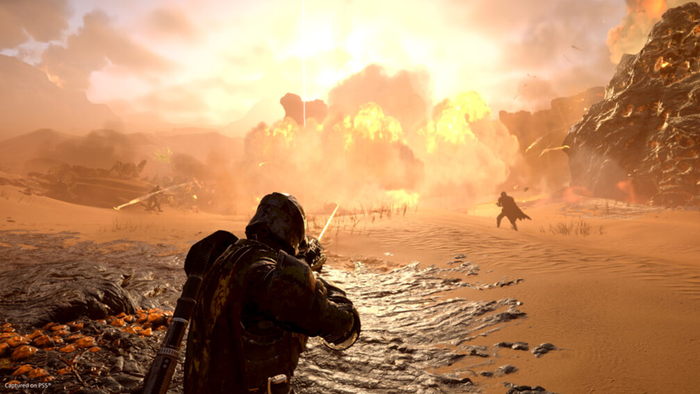Creative Game Design: Finding your voice as a professional
For a long time, I’ve been wondering if I was a real game designer. In creative industries, we very easily set up labels and categories where we try to fit people and professionals in. The issue comes when you don't feel comfortable anywhere.

For a long time, I’ve been wondering if I was a real game designer. In creative industries we very easily set up labels and categories where we try to fit people and professionals in. I was able to pick characteristics from here and there but I was not completely comfortable with what those labels said I should do as a game designer. If you fit in those labels is amazing; the problem comes, like always, when you can’t really find yourself completely represented in there but others expect you to be like that if you define yourself with a certain label.
I don’t know if more people out there feel like this, but I thought that it would be useful to write an article on how I’m trying to find my voice as a game designer in the games industry and, essentially, how I’m trying to cope with my fears and insecurities.
I’m a game designer
The first book I read about game design was The Art of Game Design by Jesse Schell. Around the first chapter, the book said that the first thing a game designer needed was to say out loud “I’m a game designer”. I was on an almost empty bus reading these words for the first time and screaming inside “I’M A GAME DESIGNER!!!!!!”. I really believed it.
I’ve been believing it for years…
… until I got my first paid job as a game designer.
If I believed in it before, if someone else believed in it enough to hire me and pay me for my work, why was I so nervous and feeling like an imposter?
It’s a combination of things but above all insecurity. At least in my case.
For years, when you typed on Google “game designer”, you usually had on the first pages people like Sid Meier, Hideo Kojima, Ron Gilbert, Tim Schafer, Shigeru Miyamoto, John Romero, Jonathan Blow, etc…
They were all typically males - with the exception of Brenda Romero, that also appeared here and there from time to time to alleviate my sufferings a tiny bit - with MANY years of experience and whose games were totally not like the ones that I want to make and that I use to make.
How can marginalized folks identify with the sentence “I’m a game designer” if just typing into the biggest search engine all what we found as role models are white males with +10 years of experience working for the biggest companies in the world?
My games are very focused on feelings and emotions. That doesn’t mean that I could not work on other kinds of games as I’ve been in the need to explain over and over and over during many job interviews for big studios in the last years. I’m able to make those but I’m good at what I do with my games: finding mechanics for expressing emotions and creating atmospheres playing with audio, cameras, mechanics and assets. Explain this as a marginalized folk and probably sooner or later you’ll have someone kindly explaining to you:
Honey, we don’t make games about emotions in here, you know?
When I make a game, I’m probably not all the technical that game designers are requested to be by some employers. I don’t use tools such as flowcharts very often, for example. Creating extremely complex systems gives me anxiety. I want to dedicate myself to create the most awesome, emotional experiences, through simple mechanics that are able to make magic. The mistake is to believe that games that use simple mechanics to reach their goal are “simple”, in the bad way. Why can’t easy things be valid and valuable too?
The thing is that I constantly felt like a failure. An imposter. I was always doubting about work and even my value. Until I was tired and done with feeling like this.
Finding my own voice as a game designer
So I tried to find my place in this tiny, big industry. That doesn’t mean that now I have everything together. It just means that I believe more often in what I’m doing. My stuff is the same, but how I approach things is different.
For some reason, in this society we kind of learn that we need to do things like everyone else because potato. We learned that things work alright like that so we don’t change because we are animals of habits and psychologically trying new things means risk.
From the creators of “We don’t animate women because it takes much more work” comes “We’ve been doing things like this since the last century so we are not gonna change now”.
And then when you feel like all of this doesn’t completely work for you it’s when you start having toxic thoughts such as “I’m not experienced enough”, “Why can’t I understand things like this?”, “Why do I hate designing complex things?”.
My first step was to keep training what I was best at instead of just keep complaining at what I was just ok: creating atmospheres and designing mechanics from figuring out first the emotions I wanted to evoke (the classic has always been all the way around).
If you haven't found yet what you enjoy doing the most or which are your strengths my best advice is, basically, to try everything until you find your own pace. If you are not able to sit down by yourself and just mess with things, sign up for jams or to any other activity that is gonna motivate you to do shit.
Once I figured out what I wanted to do and I tried and failed, I came up with a branch of game design that worked better for what I wanted to offer out there as a game designer: creative game design.
Creative Game Design
Did this concept exist before? Yes? No? Probably? I don’t care and don’t DM unless you want to recommend me some cool readings about the topic.
The thing is that I came up with this definition of my work in order to be able to tell others the services that I offer as a professional, so basically I’m not a pure, technical game designer.
My working method starts by figuring out the emotions I want to evoke in the players in that scene. Once I have that clear, I’m able to figure out the rest: cameras, sounds, light, assets.
After some months working like this and seeing how my work and productivity improved a whole lot by just changing my approach, I discovered the paper “MDA: A formal approach to game design and game research” by Robin Hunicke and other authors. This was life-changing because what they were saying was pretty similar to how I started working so, FINALLY, my insecure dumb-ass had the precious external validation that it needed to keep going.
Is this method better than the classical approach? Does it work better? I have no clue, friends. What I know is that it helps me much more to design things than other traditional approaches and, for sure, my personal method will be changing in the future as I’m constantly changing as a human being and as a professional because life just keeps going.
It’s ridiculous to pretend that everyone works in the same way, following the same rules, even when they are not the best by doing that. Let’s help people to grow and find their voices instead of blaming them for not being like us. We are in 2020!
Thus, I started defining myself as a “creative game designer” which to me basically means that I’m happy to be in charge of setting up the tone of the game as well as making mechanics that match the feelings the game wants to evoke. I’m not worse nor better than a game designer that enjoys setting up all the technical parts. We both are valid, cool and necessary.
The summary
We can’t find our own voices if we are constantly blaming ourselves for not being like everyone else. Different is nice and valuable. Without doing things differently we just can’t progress. Let’s celebrate diversity and support our peeps to grow and feel comfy by being themselves in every area of their lives.
Recommendations
Colure by Howling
Rise of the Videogame Zinesters by Anna Anthropy
Birds watching
Read more about:
BlogsAbout the Author(s)
You May Also Like













